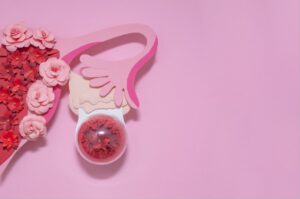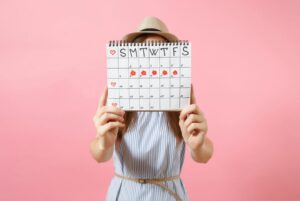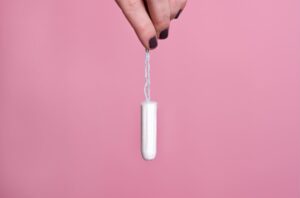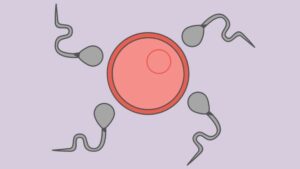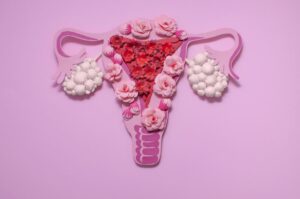Ever feel like you’re a slave to your menstrual cycle? P.volve trainer Alexia Acebo reveals how you can sync your period to your workouts, meals and mood
No energy for your usual spin class? Menstrual cramps making you too nauseous to go to work? Struggling to get out of bed?
There’s a reason you feel this way – hormones. They control everything – hunger, satiety, stress, sleeping, waking, energy levels and so much more.
As your hormones ebb and flow, so does your energy and mood
As your hormones ebb and flow, so does your energy and mood, which affects how your body may approach fitness, the foods you crave and your mental state.
Ultimately, hormone fluctuations are signals, but as women we tend to ignore these signals and ‘just get on with things’ to the detriment of our health and happiness.
Menstrual cycle syncing – what is it?
Many people may see hormonal fluctuations as a downfall, but P.volve Phase and Function trainer, Alexia Acebo sees things differently.
‘Thanks to cycle syncing women get the opportunity to adapt their bodies and lifestyle to a schedule,’ says Alexia.
‘The Phase and Function program by P.volve helps women by syncing movement, mindset and meals into the four phases of their menstrual cycle, also known as menstrual cycle syncing’.
Phase and function also supplies all the education that’s needed surrounding the four phases of the menstrual cycle, including how you should be feeling.
‘By paying attention to your hormone fluctuations and changing your lifestyle accordingly, you can optimise your health and fitness goals’.
P.volve helps women by syncing movement, mindset and meals into the four phases of their menstrual cycle
According to a study published in the journal Archives of Gynecology and Obstetrics, hormone fluctuations during the menstrual cycle play a crucial role in our body’s responses, including our emotions, appetite, thought processes, and more.
The study found that women reported high levels of well-being and self-esteem during the middle of their cycle, and increased feelings of anxiety, hostility, and depression before their period.
‘If you find yourself with more energy at a certain time in your cycle, capitalise on that and push yourself harder at the gym. If you feel less hungry during certain times of your cycle, use that time to have smaller portions in order to maintain or lose weight,’ explains Alexia.
Menstrual cycle syncing – how do we do it?
The first step to syncing your life to your cycle is to track your menstrual cycle, and there’s several ways to do this.
Alexia suggests a good old fashioned calendar, a plethora of cycle tracking apps or even the Apple Health app feature (if you have an iPhone).
‘Once you’re aware of your cycle, you’ll start to notice trends. You may feel a certain way or pick up on a particular craving, and you’ll start to recognise when these similarities come about every month,’ says Alexia.
‘Once you have tracked the four different phases of your cycle, you can start to build a structure around your lifestyle that includes adapts movement, meals and mind to the different stages of your cycle, leading to a balance in your hormones’.
Menstrual cycle syncing – what benefits can we expect?
‘I have been cycle syncing for around three and a half years and after just one cycle I begun to notice the benefits,’ reveals Alexia.
‘When your body and therefore hormones are in balance, you’ll notice benefits such as, reduced cramps and nausea, mental clarity, the ability to socialise and relate well to other people, mood improvements and the motivation to treat your body well.
Mitigation of stress – ‘cycle tracking takes the stress away that we put on ourselves as women around food movement and mindset’.
Weight loss or maintenance – ‘not pushing your body when you don’t have to and learning about the shift your cycle has on your metabolism leaves you with more energy and less bloating’.
Reduced PMS – ‘no woman is ever supposed to experience PMS as it’s a result of hormonal imbalance’.
‘When you start to align your movement, meals and mind with your fluctuating hormones, you body will thank you by not being inflamed, stressed, bloated, cramped and fatigued’, explains Alexia.
‘Even your confidence will improve, simply by knowing you’re fuelling your body well and making healthy decisions – which is extremely empowering’.
How to sync your mindset, movement and meals in relation to your menstrual cycle…
Menstrual Phase (bleeding – Day 1)
During menstruation, you’ll want to match your low hormone levels by taking a mindful pause, moving gently and eating food that will help to replenish your body.
Movement:
On the first day of your period and for the rest of this phase focus on recovery movement – think stretching, hip openers, spine rotation and building circulation gently around the body.
don’t forget to pamper yourself!
Plus, opt also for yoga or meditative walks through nature, rather than pushing yourself hard at the gym.
‘By increasing circulation, you are helping your body get rid of what it’s trying to get rid of, instead of letting things getting stagnant and inflamed,’ explains Alexia.
‘Rest is also key, don’t forget to pamper yourself!’
Meals:
According to Christiane Northrup, author of Womens Bodies, Womens Wisdom, the menstrual cycle should incorporate foods that symbolise the four seasons.
‘The menstrual phase should focus on winter season foods. This includes consuming warming and grounding foods such as, soups and stews,’ reveals Alexia.
each meal should include protein to ensure you are getting sufficient amino acids
‘During your bleed, you should consume healthy and wholesome foods that will help mitigate inflammation, replenish nutrients and encourage balance as your hormones reach their lowest levels.
‘Focus on consuming energising carbs, healthy fats and low glycemic fruits and veggies.
‘Plus, each meal should include protein to ensure you are getting sufficient amino acids that are necessary for hormone production’.
Mindset:
With hormones at their lowest level during the menstrual phase, you’ll experience clarity and communication between the right and left brain which will allow you to make sound, true to yourself decisions.
‘So, if you’re thinking about making any big life changes such as a career move, relationship or friendship shifts, or if there’s something that has been playing on your mind, this phase is the time to sit down, reflect and come to a decision,’ says Alexia.
Follicular Phase (pre-egg release – Days 7 to 12)
After menstruation, you’re primed to match your hormone shift with maximum creativity, faster-paced movements and fresh, vibrant foods.
Movement:
Once the uterine lining has been shed and hormones start to rise, you’ll have energy to spare.
‘Hormones are rising and there’s newness in the body, so this is a great time to connect with that increase in energy with regular exercise,’ explains Alexia.
Keep exercise to moderate intensity such as hiking, light runs or more flow-based yoga that works up a sweat.
Meals:
‘After your bleed, prioritise foods that match the energy of your rising hormone levels, and according to Christiane Northrop, this phase is like an internal spring,’ explains Alexia.
also crucial to support gut health with fermented foods like sauerkraut or kimchi
‘Oestrogen and insulin sensitivity are increasing, so fuel yourself with carbohydrate-forward foods (grains, potatoes, fruit) while your body is able to utilise them properly and maintain blood sugar stability.
‘Fresh, steamed and sautéed ingredients will feel best during this phase too. It’s also crucial to support gut health with fermented foods like sauerkraut or kimchi and detox the body with cruciferous greens like broccoli’.
Mindset:
Alexia recommends using the energy from rising oestrogen in the follicular phase to focus not just on fitness goals, but on career and relationship goals too.
‘The follicular phase is a time to focus on brain storming newness, dream big, plan the future and goal set,’ reveals Alexia.
Ovulatory Phase (process of release of the egg – Days 13 to 16)
Take advantage of your maxed oestrogen levels during ovulation by speaking up, challenging your body and refuelling properly.
Movement:
‘During ovulation your energy is through the roof – testosterone and oestrogen are peaking, maximising your workout potential,’ says Alexia.
‘This is the time to take on a kick boxing class, try that new boot-camp class, spin or a high intensity interval workout.
During ovulation your energy is through the roof
‘Push your body, and do a workout with a friend, make it fun, strength and power will feel intuitive during this phase’.
Meals:
‘Ovulation phase is like the summer season according to Christiane Northrup. This is where you should be consuming cold, raw, energising, fibrous foods,’ explains Alexia.
‘Be sure to eat foods that set you up for success as energy and workout intensity hits its peak.
‘Plus, make sure you take in enough nutrients for workout recovery here, especially protein and as always, keep that water bottle nearby and prioritise hydration.
‘As oestrogen drops after ovulation and progesterone begins to rise, so will insulin resistance which means your body is less able to metabolise carbohydrates well,’ explains Alexia.
‘Replace some of those simple carbohydrates from the follicular phase with healthy fat such as fatty fish, nuts and seeds’.
Mindset:
During ovulation your communication skills are improved as rising testosterone provides you with more confidence.
This can help you deliver on the goals you have thought about and planned during the other three phases of your cycle.
Alexia suggests that now is the time to ask for a raise, end your relationship or ask your crush out on a date!
Luteal Phase (post-egg release – Days 17 to 28)
During the luteal phase, get ready to experience a progesterone high that will lead to an organised mind. Shorter workouts and satisfying, nutrient-dense foods are key during this phase.
Movement:
The luteal phase – the phase right before your period – is when women tend to experience wild PMS symptoms, such as low energy, cramps, headaches and acne.
‘When it comes to exercise, it’s hard not to beat yourself up during this phase, where you find yourself wondering why you can’t do that same hour and a half power yoga class that you did so easily last week,’ reveals Alexia.
your basal body temperature has risen so you are feeling hotter and sweatier than usual
‘There’s nothing wrong with you, trust me. What’s happening is that your basal body temperature has risen so you are feeling hotter and sweatier than usual, your energy is lower and your body is getting ready to bleed for a week.
‘My advice is to keep your workouts to 30 minutes and keep the intensity relatively low. This is so you don’t get a spike in cortisol, whereby the body could go into fat storage.
‘If you wake up and you’re exhausted and know your body can’t do it, opt for yoga, a walk in the park, a slow swim or a rest day.
‘The way you move can have a direct impact on inflammation, so the goal is to not encourage any more than there already is with heightened stress or spikes in cortisol’.
Meals:
‘The luteal phase is like your internal autumn according to Christiane Northrop – so opt for more grounding foods such as, sweet potato, squash, oven bakes, red meat and roasted foods,’ suggests Alexia.
try to avoid alcohol, carbonated drinks, artificial sweeteners and added salt
‘Prioritise foods that satisfy cravings such as healthy fats to curb the desire for sugary desserts. If you have a sweet tooth, try some dark chocolate and a couple of dates and see how satisfied you feel.
‘At this phase of the cycle most women experience symptoms of anxiety, so try to avoid alcohol, carbonated drinks, artificial sweeteners and added salt’.
Mindset
‘During the luteal phase, it’s time to turn inward and wrap up any loose ends,’ suggests Alexia.
‘Finish your to do list, pay the bills, do the house chores. This phase is not the time to take on any new or creative projects’.
The Phase and Function program was created by P.volve trainers Alexia, Antonietta and Maeve, in partnership with Dr. Suman Tewari, OB-GYN and Dr. Vanessa Rissetto, R.D and was designed to help mitigate period-related symptoms and improve energy levels.
More Healthista Content:
The best exercise for menopause
Top Dietitian explains the first 4 KEY steps to successful weight loss
Foodie Friday: roast salmon, avocado & puy lentil salad
Stomach problems? 3 common tummy troubles and how to treat them
Postnatal exercise – an expert guide to running after giving birth
Like this article? Sign up to our newsletter to get more articles like this delivered straight to your inbox.




